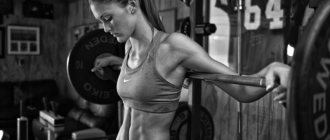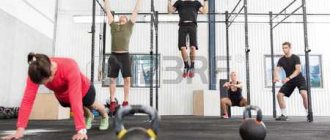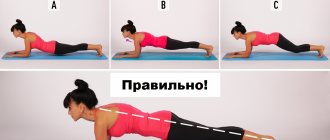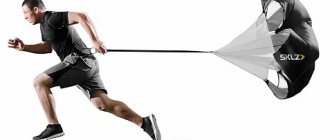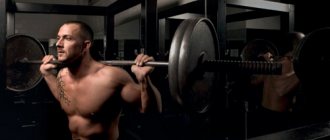Just 10 years ago in the world of fitness, the concept of CrossFit was new and unfamiliar, but now the choice of this sport for regular training no longer surprises anyone. Almost all fitness centers have CrossFit instructors, tournaments are regularly held, and the Internet is replete with videos with unique exercises performed in an “explosive” manner and so strikingly different from the movements from the usual arsenal of bodybuilders and lifters.
CrossFit has gathered around itself a huge army of loyal fans, however, there is also a lot of negativity and criticism (justified and not so well-founded). This article makes an attempt to “break down” the concept of CrossFit for those who are interested in this topic and consider this system for themselves as a promising direction in training.
See also:
- Top 20 Best Men's Fitness Shoes
- Top 20 Best Women's Fitness Shoes
What is CrossFit?
CrossFit is a versatile workout that takes an athlete's functional development to the next level. CrossFit is a combination of:
- Fitness;
- Weightlifting;
- Athletics;
- Bodybuilding;
- Powerlifting;
- Gymnastics;
- Kettlebell lifting.
CrossFit is the most varied training possible. The athlete regularly receives new tasks, which reduces the likelihood of overtraining and emotional fatigue from training.
CrossFit develops the following parameters:
- Endurance . Crossfitters have more endurance than bodybuilders or strength athletes. The ability to perform muscle work for a long time is the crossfitter’s main trump card in a dispute with the “iron brothers.”
- Cardiovascular and respiratory systems . CrossFit takes heart and lung performance to the next level. If now you are out of breath after climbing to the fifth floor, then after a year of training you will be able to run to the 20th floor without the slightest shortness of breath.
- Performance . Muscular performance is the essence of bodybuilding. The consequence of developed muscle performance is impressive muscle mass. Crossfitters are inferior to bodybuilders in developing muscle performance, but they also have developed performance capacity.
- Strength . The least developed parameter for a crossfitter. Muscular strength is the ability to lift a maximum amount of weight for one repetition. This is the essence of powerlifting and other strength sports. In developing maximum strength, a crossfitter is inferior to a powerlifter and bodybuilder.
- Functional readiness . A CrossFitter is the most prepared person for various life situations. Example: your girlfriend injured her leg and you need to take her to the nearest hospital. It's a 15-minute walk to the hospital.
A CrossFitter can complete the task in 15 minutes. Bodybuilder - over 25. Powerlifter - over 50. A powerlifter can lift the weight of 4 girls, but after 3 minutes on his shoulders with one girl he will be exhausted. A bodybuilder will lift the weight of 3 girls, but within the framework of the task he will exhaust himself in 6 minutes. A krpossfitter will be able to lift the weight of 2 girls, but with one on his shoulders it will take 15 minutes, as if walking only with his own weight.
In everyday life, CrossFit will be much more useful to you than any strength sport.
- Nervous system . Thanks to regular, varied exercise, the nervous system is strengthened. The mental power and endurance of a person increases. Stress resistance increases.
- Willpower . After another set of heavy circuit training, the athlete wants to give up, rest, and give up halfway through. But he finishes what he started, gets a huge buzz from it and transfers this skill to life. CrossFit builds willpower, which will make you more successful in everyday life.
- Self-discipline . The longer an athlete works on himself, the more disciplined he becomes. This skill also transfers to everyday life.
With the help of CrossFit you can develop any physical qualities. The main thing is to create the correct training program to achieve a specific goal, which we will teach you in this section.
Crossfit competition
The CrossFit system was originally developed not only as a training method, but also as a competitive sport. And this is its significant advantage, since holding competitions attracts many participants from other types of fitness. And the need to achieve the highest level of physical fitness develops training methods.
It has long been known from practice that people who regularly participate in tournaments and competitions are always in much higher physical shape than those who do not regularly participate in competitions, even if they constantly train.
If you wish, you can join regular competitions by contacting the nearest fitness club that has a crossfit section.
Crossfit. Training principles
Any private recommendations for CrossFit do not work without knowledge and application of the key training principles of training:
- The principle of load progression;
- Supercompensation principle;
- The principle of gradualism.
Understanding these three principles is 80% of success in CrossFit.
Let's look at each principle separately.
Crossfit and nutrition
In his articles, Greg Glassman clearly states that CrossFit training must be combined with a careful approach to diet.
The founder of CrossFit recommends following the following scheme:
- 40% carbohydrates;
- 30% protein;
- 30% fat.
The daily diet should be determined at the rate of 1.8-2.5 g of protein per 1 kg of “dry” muscle mass:
- with moderate daily training loads, the norm is 0.7 (1.8) g;
- with increased physical activity - 1.0 (2.5) g per 1 kg.
The basis of nutrition is vegetables, lean meat, nuts, seeds. Sugar and foods with a high glycemic index are prohibited. It is also not recommended to consume foods with a long shelf life.
Supercompensation principle
The principle of supercompensation regulates the frequency of training. This is an opportunity to learn to feel your body and work on it exactly when it is most effective.
To understand the principle of supercompensation, let’s divide the training cycle into 5 phases:
- Traumatization . A phase that lasts throughout the workout. Muscle fibers are injured, and other systems of the body receive microtrauma. Important: during training, muscles are injured, not grown. By training you make possible growth in the future, but not in the present. Therefore, there is no point in training too often.
- Fast recovery . Within 30-60 minutes after completing the workout, the hormonal system is partially restored, and the nervous system recovers from maximum tension. The cardiovascular and respiratory systems are restored after stress. Treatment of the resulting muscle injuries begins.
- Slow recovery . The phase lasts until all body systems are completely restored to pre-training levels. Muscle recovery occurs, and the desire to exercise appears.
- Supercompensation . The body creates a reserve in case of repetition of a similar load. If during the first workout the load was prohibitive for you, then if you repeat a similar load, it will seem more familiar to you. The body has adapted to it in order to spend fewer resources. After adapting to the current load, you need to give the body a new training stress. Carry out a progression of loads. This is only possible in the supercompensation phase. Training only makes sense in the supercompensation phase!
- Loss of super compensation. If the athlete does not train in the supercompensation phase, the body stops maintaining the created reserve and the body returns to its pre-training state.
Using pull-ups as an example, a workout in various stages of recovery might look like this:
Monday. Training
| Exercise | Weight | Approaches | Repetitions | Rest minutes between sets |
| Chin Pull-Ups | Own body + 10 kg | 5 | 12 | 1 |
Tuesday. Recovery phase. You can't train
| Exercise | Weight | Approaches | Repetitions | Rest minutes between sets |
| Chin Pull-Ups | Own body + 10 kg | 2 | 5 | 1 |
Congratulations, enthusiasts: with your second workout, you have increased the concentration of stress hormones to the limit. The training didn't work. Now you feel completely broken, in the morning your whole body will be very sore, and it will take much longer for your body to recover. The consequence is a slowdown or complete lack of progress.
Wednesday. Recovery phase. You can't train
| Exercise | Weight | Approaches | Repetitions | Rest minutes between sets |
| Chin Pull-Ups | Own body + 10 kg | 4 | 10 | 1 |
The recovery is not yet complete. You cannot repeat the volume of a previous workout.
Thursday. The recovery phase is over. You can't train
| Exercise | Weight | Approaches | Repetitions | Rest minutes between sets |
| Chin Pull-Ups | Own body + 10 kg | 5 | 12 | 1 |
The recovery is over, but supercompensation has not yet arrived. Training does not harm, but does not bring benefits.
Friday. Supercompensation. You can train
| Exercise | Weight | Approaches | Repetitions | Rest minutes between sets |
| Chin Pull-Ups | Own body + 10 kg | 6 | 12 | 1 |
The optimal moment for training. You fell into supercompensation and managed to comply with the principle of load progression.
Saturday. Supercompensation. You can train
| Exercise | Weight | Approaches | Repetitions | Rest minutes between sets |
| Chin Pull-Ups | Own body + 10 kg | 6 | 12 | 1 |
Another optimal day for training.
Sunday. Supercompensation is gradually lost. You can train
| Exercise | Weight | Approaches | Repetitions | Rest minutes between sets |
| Chin Pull-Ups | Own body + 10 kg | 6 | 12 | 1 |
You managed to follow the principle of progression of loads, but the last repetitions were especially difficult.
Monday. Super compensation lost
| Exercise | Weight | Approaches | Repetitions | Rest minutes between sets |
| Chin Pull-Ups | Own body + 10 kg | 5 | 12 | 1 |
The athlete returned to pre-training conditions. You can train, but you won’t be able to follow the principle of progression of loads.
The problem with most amateur athletes is that training is carried out at the wrong time. Either in the recovery phase (the athlete receives an excessive amount of stress hormones, driving himself into overtraining), or in the phase of loss of supercompensation (undertraining).
Over time, you will learn to understand the body and accurately determine the optimal moment for training.
Now proceed from the following rules:
- During training, the working muscle group should not hurt. There should be no muscle discomfort. Pain and discomfort are signs of the recovery phase.
- Excessive psychological fatigue is a companion to the recovery phase of the nervous system. Drowsiness, lethargy during or after training is another signal that you need to take a break.
- The inability to adhere to the principle of progression of loads with sufficient recovery is an indicator that you either “jump over” the supercompensation phase, do not notice it, or overestimate the degree of readiness for training.
What else is important to know about CrossFit
When forming training in CrossFit, you should avoid, if possible, repeating loads on the same muscle group within the same circle (or at least alternate them). Otherwise, the muscle group “acidified” by lactic acid will not allow you to fully move forward to the next exercises and circuits. It’s easier to adhere to this principle if you alternate exercises in accordance with their focus:
- clean and press
- various pulling movements
- exercises for leg muscles - different squats and lunges
- aerobic and cardio exercises – running, jumping
Types of CrossFit workouts
There are a great many training programs in CrossFit and it is not possible to describe all the options in one article. However, three main groups of training programs can be distinguished, differing conceptually:
1. Speed training
In this workout, you need to complete a set number of repetitions and speed circuits. For example, one circle includes: 20 push-ups, 15 jumping jacks, 30 barbell presses, 30 kettlebell swings. The task is given to complete 8 such circles. Your task is to make a given number of laps as quickly as possible.
The result of such training will be time. This type of training in CrossFit is also called AFAP (as fast as possible).
2. Training for the number of rounds
In this workout, you need to complete as many laps as possible in the allotted time. For example, 20 minutes are allotted for training. One circuit includes: 20 jump squats, 20 kettlebell pushes, 20 medicine ball throws, 10 push-ups. Your task is to make as many of these circles as possible in the allotted 20 minutes.
The result of such training will be the number of laps. This type of training in CrossFit is also called AMRAP (as many rounds as possible).
3. Timed training
This type involves dividing the workout into intervals of work and rest. For example, you work for 45 seconds, rest for 15 seconds, then do the next exercise. Or you work for 1 minute, rest for 1 minute. The size of work and rest intervals is selected depending on the intensity of the exercises and the level of training of the group.
With this kind of training, you need to fit as many repetitions as possible into a limited period of time. For example, you need to do the maximum number of burpees in 30 seconds. At first it may be 4-5 repetitions, but as endurance increases, this value will increase over the specified period of time.
CrossFit tips for beginners:
- Follow the regime. Results not only in CrossFit, but also in sports in general, in addition to training and nutrition, depend on lifestyle in general. It is absolutely necessary to “quit” bad habits such as smoking, not to overindulge in nighttime activities with large amounts of alcohol, etc. You need to get enough sleep - chronic lack of sleep reduces the secretion of testosterone.
- Keep a training diary in which you record exercises, the number of repetitions performed, how you feel before and after training, etc. Weigh yourself regularly and take basic anthropometric measurements: a trainee who tracks all this can, not without interest, monitor changes in his physical condition.
- When creating a training program when starting CrossFit, you need to take into account your previous sports history (or lack thereof). It is logical to assume that aerobic exercise may be a weak point for a strongman, while a long-distance runner may have strength exercises (especially for the upper body). These are the “weak points” that need to be improved during the initial period of training.
- You should never neglect warm-up and safety precautions during training. So many people have been injured because they neglected little things.
- A number of exercises - especially those from the arsenal of weightlifters (snatch and clean and jerk) are actually quite technically complex. There is no need to waste time learning the correct technique.
- Progress, while surprisingly fast in the first few weeks of training, will slow down over time as... “neurological development” will take place. You need to understand this aspect of the training and be mentally prepared for it.
- The diet of a crossfitter may differ slightly from the diet of security forces. Eat right (more on that below).
- Learn to tolerate physical discomfort during exercise. By avoiding discomfort, you will greatly slow down your progress (of course, you need to know moderation in everything).
- During the warm season, don't neglect the opportunity to exercise in the fresh air. This will add variety to your workouts and “unload” your psyche.
- Beginners should not get carried away with “amateur activities”. Listen to the recommendations of experienced instructors, regularly read literature on CrossFit, compare methods, and analyze.
Nutrition when doing CrossFit
CrossFit training is characterized by high energy expenditure over a relatively short period of time. The diet of a certain part of crossfitters is practically no different from the diet in bodybuilding.
It is believed that a CrossFitter’s nutrition, divided into proteins, fats, and carbohydrates, should differ in the amount of calories supplied to the body by the following percentage:
- Proteins – 30%;
- Carbohydrates – 40%;
- Monounsaturated fats – 30%.
In addition to the main meals during the day, in relation to training, it is advisable to adhere to the following diet:
- Two meals are needed before training: the first 2-4 hours, the second 1-2 hours before training. The second “snack” is lighter, mainly consisting of “fast” carbohydrates, which will replenish glycogen stores immediately before training. You can’t do CrossFit in the morning on an empty stomach.
- Post-workout meals: immediately after training, you can take a portion of sports nutrition (for example, whey protein or gainer), which will restore fluid loss in the body and help restore glycogen reserves; a couple of hours after training you can eat more heavily.
Among those who practice this sport, there are many supporters of the so-called paleo diet: its essence is to eat the same way as the ancient people did in the Paleolithic era, i.e. eat meat, fish, fresh vegetables and fruits, nuts. Accordingly, various dairy products and foods high in salt and sugar are excluded, as well as culinary “delights” - smoked meats, fatty fried foods, etc. The Paleo diet is considered to be “natural” and the most optimal for humans. It is difficult to say which approach is more justified; the athlete will have to determine for himself the principles of constructing a diet that are most optimal for him.
CORRECT NUTRITION: where to start step by step
Common mistakes when training in CrossFit
- Attempts by beginners to achieve everything at once, neglecting the natural laws of physiology and training methods. This is obviously unrealistic - progress in sports is gradual.
- The desire, in pursuit of a formal number of repetitions (and formal time), to count towards oneself poorly performed repetitions - undersquatting in squats, burpees without jumping, partial repetitions in pull-ups, etc.
- Ignoring injuries in pursuit of sports results. If an injury has occurred, you need to be treated and restored; training at full strength in such circumstances is unacceptable.
- Changing the balance in training in favor of those exercises that you like, while simultaneously ignoring what you don’t like or don’t do well.
- A complete lack of breaks in training for a very long time is a direct path to overtraining and diseases of the cardiovascular system.
What else we recommend reading for CrossFit:
- All about the burpee exercise: the main crossfitter exercise
- All about push-ups and types of push-ups for all levels
- All about pull-ups: how to learn to do pull-ups
The principle of gradualism
The principle of gradualism is a mechanism that links load progression and supercompensation together.
The training process is not a fairy tale about a superhero who is bitten by a spider and instantly gains super strength. This is not a leap that allows you to achieve what you want in days, weeks or months. This is long, leisurely, slow work.
We start with the simplest load and step by step we move to the heights of the CrossFit Olympus.
Let's see this gradualness using the example of running training:
Workout #1
| Exercise | Duration in minutes |
| Run | 5 |
Workout #2
| Exercise | Duration in minutes |
| Run | 7 |
Workout #3
| Exercise | Duration in minutes |
| Run | 10 |
Workout #4
| Exercise | Duration in minutes |
| Run | 12 |
Workout #5
| Exercise | Duration in minutes |
| Run | 14 |
Workout #10
| Exercise | Duration in minutes |
| Run | 28 |
Workout #20
| Exercise | Duration in minutes |
| Run | 45 |
Workout #30
| Exercise | Duration in minutes |
| Run | 60 |
After 30 workouts, we managed to reach 60 minutes of running in our comfort zone. We gradually pushed the boundaries of our comfort zone, as a result of which we became quite good runners without excessive stress and suffering.
Beginning male and female athletes tend to train in spurts. “Today I run for an hour, and for the next 2 weeks I lie on the couch” - this scheme does not work in CrossFit or any sport in general. Only a gradual increase in load allows you to achieve results.
To achieve results in CrossFit you need:
- Follow the principle of load progression. Adapt to new stress every 1-4 workouts.
- Train in the supercompensation phase. Only then is growth possible.
- Increase the load gradually. Plan workouts, keep a training diary.
Crossfit exercises. Examples.
CrossFit classes are based on various functional exercises. They came from other sports: gymnastics, weightlifting, powerlifting and the physical training systems of the army, fire service, police and special forces. And some exercises look like adult strength games or children's games


